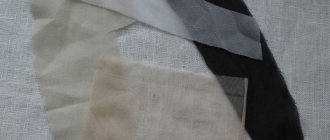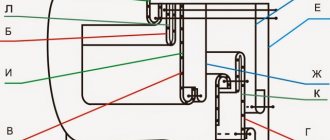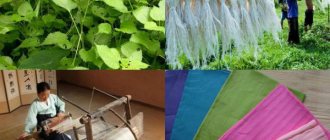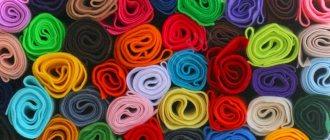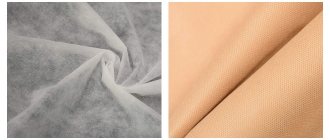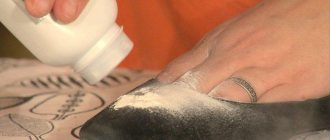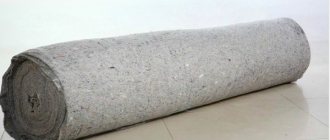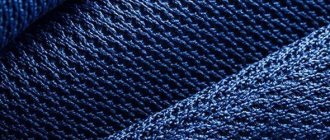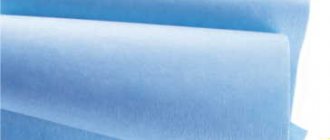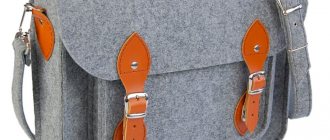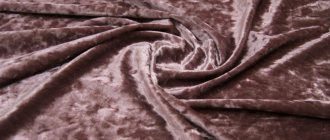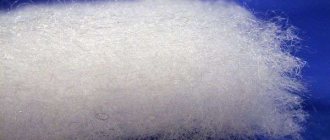Many people associate the concept of “nonwoven material” with modern technologies. In fact, humanity learned to make this type of textile more than one hundred years ago. An example of such products could be felt boots or tents of nomads. Modern non-woven fabrics are made from different materials, in different ways. They are used for sewing clothes and in other fields.
Scope of application of nonwoven materials
The fact is that the scope of application of such paintings is extremely widespread. Examples include the following areas:
- manufacture of wearing apparel;
- geotextiles;
- shoe making;
- furniture production, etc.
These are just a few of the areas in which nonwovens have recently become widely used. Also, division into classes is carried out according to the composition of the raw materials. Naturally, natural ingredients are used in the vast majority of cases in the production of clothing and footwear.
Meanwhile, the most important criterion when choosing a specific nonwoven material is the method of its production. Today, the following are distinguished: adhesive, canvas-stitched, needle-punched, etc.
Application area
Non-woven fabrics are used in all industries. Medical products made from nonwoven materials include shoe covers, disposable suits, gowns, caps, postoperative bandages, and plasters.
Nonwoven materials are used to make clothes for workers in food production, restaurants, and cleaning companies. These include overalls, aprons, and gloves.
Fire-resistant fabrics are used to make protective clothing for hazardous industries. Filters and gaskets are made from it. Nonwoven materials with high hygroscopicity and density are used in construction for moisture insulation and insulation.
Cloths are also used in agriculture to protect crops from bad weather and pests. They contribute to faster ripening of the crop.
Non-woven fabrics are used when sewing outerwear as insulation. They are used as fillers for pillows, blankets, and mattresses.
Fabrics are widely used in everyday life. They are used to make organizers for shoes and covers for storing clothes. Shopping bags, bags, and sacks are made from nonwoven materials.
They are used to produce cleaning products - rags, mops. Non-woven wipes are suitable for polishing cars, furniture, and other delicate surfaces.
Disposable and reusable tablecloths and towels are made from non-woven material. It is also used as a filler for furniture.
Use as insulation and lining
Indeed, nonwoven materials are quite often used in the field of insulation. Thanks to the described production methods, high heat-saving qualities are achieved.
Naturally, depending on the purpose, materials using a large number of synthetic fibers can also be used. As a rule, such options are made using the adhesive method.
Lining materials are made by needle punching. Often, such options are used to further enhance the strength and rigidity of the fabric. The most common example is non-woven fabric.
It strengthens not only collars, but also stands, cuffs, hems of dresses, etc.
In addition to all of the above, nonwoven materials are also used in the production of geotextiles. It is used to provide protection against displacement of soil layers in an area relative to each other (there are other applications).
See also:
- Find out what needle-punched geotextiles are.
- Recommendations that will make it possible to open the front door - https://archivis.ru/post/articles/uslugi/kak-vskryit-vhodnuyu-dver
The video demonstrates various nonwoven materials:
Types and their properties
One classification of nonwoven materials is based on their area of application. They are divided into:
- technical _ They are used in industry and agriculture. As protective equipment, filters, gaskets, cleaning materials;
- medical _ Non-woven fabrics are used to produce workwear, hygiene products, bandages, shoe covers;
- household . They are used for the production of clothing (sintepon, felt, leatherette), storage covers, and cleaning products.
What is felt?
Photo Technical fabrics include various types of building insulating materials. For example, isobond - it is used to protect buildings from condensation and moisture. It is also used as insulation.
Technical fabrics include:
- non-woven wiping materials . They are used for polishing cars and other delicate surfaces. There are several forms of release - rolls and napkins;
- lint-free nonwovens . Used in floor and wall dispensers. They are suitable for cleaning various surfaces from moisture or grease;
- non-woven abrasive materials . They are made from polyester or nylon fibers containing abrasive particles. They are used for grinding and cleaning. The materials have received household use, they are used to produce sponges for washing dishes;
- non-woven fire-resistant filter materials . They are produced from meta-aramid and para-armamid fibers using the needlepunch method. They are heat resistant, lightweight and durable. They are used to produce industrial filters and workwear.
Another type of technical, non-woven materials is covering fabrics. They are used in agriculture to protect crops and increase productivity. Spunbond non-woven material is widely used. It is produced by the heat setting method. As a rule, this is a three-layer fabric. The density of agricultural nonwoven material affects its scope of application. The densest fabrics are used to protect crops from cold and frost, and to “preserve” perennial plants for the winter. Less dense mulching non-woven fabrics protect crops from pests. I produce spunbond in black, white, green and multi-color.
Spunlace is used for the production of medical products and hygiene products. It is produced using hydrojet technology. The composition includes cotton, viscose and polypropylene threads. They determine the properties of this non-woven material - moisture absorption and retention. The canvas also allows air to pass through well. It is used to produce wet wipes, sanitary pads, diapers, and disposable diapers.
Fibrella is another non-woven material for the production of cosmetic wipes, disposable medical gowns, and caps.
For the production of clothing they use:
- padding polyester It is used as insulation for outerwear or filling for pillows or blankets. The fabric is produced by adhesive or thermal methods;
- non-woven fabric is a cushioning material produced by the adhesive method. It is used to seal clothing parts. A thin variety of gossamer is used for hemming trousers;
- Thinsulate - insulation made from hollow polyester fibers. It retains heat perfectly, holds its shape well, and prevents deformation of products after washing.
Types of nonwoven materials
Nonwoven materials are products prepared from chemical fibers. There are several types of non-woven coverings available for sale, differing in technical parameters and properties. Similar results were achieved using a variety of manufacturing techniques. To make it easier to decide, it is worth familiarizing yourself with the main types.
Spunbond
The preparation of such material is carried out by pressing pre-prepared raw materials through special dies, the diameter of which is relatively small. Only after this the fibers are thoroughly cooled, drawn out, and laid on a flat surface. In order to connect the prepared and cooled fibers, a calender is used.
The fabric prepared in this way is distinguished by its increased level of density, wear resistance, and strength. This material is waterproof, easy to store and use. It is quite often used in the process of preparing non-sterile products.
Spunlace
The preparation of this nonwoven material is carried out practically according to the same principle as spunbond. The only difference is that the fibers are intertwined using water jets that are supplied under high pressure. This type of non-woven material is made from polypropylene, viscose, and polyester fibers. In some cases, several types of fibers are combined. As a rule, several types of fibers are combined if it is necessary to enhance certain properties of the fabric.
This type of nonwoven material has the following advantages:
- Excellent tactile comfort.
- The coating does not interfere with free air circulation.
- The durability of the coating is quite high.
- The material has excellent protective properties.
- The elasticity coefficient of the coating is quite low.
This type of non-woven material should not be used in excessively humid climates, since it absorbs moisture well, and its weight increases.
What are they made from?
Nonwoven materials are made from natural and synthetic fibers, fibrous waste, by mixing various materials. The quality of products is regulated by State Standard 9 092-2014.
Non-woven fabric is the base and binding component. The base consists of fibers, threads, cut fabrics, located side by side on the same plane. The binder is the threads that stitch the fabric and adhesive materials. Some substrates are capable of adhesion under pressure or heat, so they do not require a bonding agent.
The order of the fibers on the canvas is of great importance. They can be laid longitudinally, transversely and randomly.
The direction of the fibers affects the properties of the fabric. If they are oriented lengthwise, the canvas will be much stronger in that direction. With a random arrangement of fibers, the fabric is equally strong in all directions.
When cutting it, you do not need to follow the fractional pattern. However, fabrics with a random arrangement of fibers are less durable than those with an oriented one. Sometimes, to increase strength, a frame made of a transverse system of threads, gauze, or polymer film is placed on the surface of the nonwoven material or between its layers.
One of the main characteristics is the density of the nonwoven material. It is determined in grams per square meter. Density is set by manufacturers by adding or subtracting the amount of raw materials. The density of a nonwoven fabric can be increased by folding multiple webs and fastening them together, which increases the overall thickness.
Composition of nonwoven materials
Currently, nonwoven materials are prepared from:
- Natural fibers: wool, cotton, linen.
- Chemical fibers: polyamide, viscose, polypropylene, polyester, others.
- Secondary raw materials obtained from waste from chemical and other industries.
In order to ensure reliable connection of fibers, manufacturers quite often use lavsan, glass, nylon or metal threads.
Before raw materials go into production, they must be prepared. Preparation processes are determined depending on what kind of raw materials and what manufacturing technique is used.
Production process and techniques
The production of non-woven fabric begins with cleaning and sorting of raw materials with parallel preparation of binders. Afterwards the fibers from which the fabric will be formed are laid.
There are different types of canvas formation:
- Dry using chemical bonding, thermal bonding, needle punching or spunlace technologies.
- Wet, in which the fibers are first placed in water to disperse them, and then on a special membrane material to separate from the water and obtain uniform sheets.
- Spunbond technology consists of passing a melt of polymers through tiny holes or dies in the direction from top to bottom towards the air flow. The polymer jets, when dried, turn into fibers, and when placed on a conveyor they form a web. To fasten threads, the following are used: water-jet connections, heat treatment, impregnation with chemical binders, and needle puncture.
- During aeroforming, a homogeneous mixture of air and raw materials is first obtained. Then moving breathable wire or tape is used to form the canvas.
At the final stage, the canvases are dried, dyed, and bleached.
Table 1. Technologies for the production of non-woven fabric in 2015 (in thousands of tons).
| Way | Japan | China |
| Wet | 32 | 30 |
| Dry | 27 | 100 |
| Spunbond | 110 | 1370 |
| Hydrojet | 42 | 500 |
| Needlepunched | 70 | 640 |
| Thermobonding | 40 | 135 |
| Chemical bonding | 18 | 120 |
The table shows that the most common method of producing nonwoven materials in 2015 was spunbond. The trend has continued to this day. In second place are needle-punched technologies, in third place is the hydro-jet method or spunlace.
Properties of nonwoven materials
Nonwoven materials have a number of unique properties:
- Uniformity of structure. Due to the fact that the fibers used in production are connected as firmly as possible and are distributed evenly, the load on the material is distributed evenly along the entire perimeter. This eliminates the possibility of deformation, excessive tension of the coating, or violation of its integrity.
- Density. Since nonwoven materials have a higher level of density, they can be used to minimize the evaporation of moisture from the ground. As a result, watering rates will also be reduced.
- The material helps maintain an optimal temperature level, due to which the soil warms up much faster.
- High level of strength. Neither mechanical load nor chemical components affect the basic properties of the nonwoven material. Therefore, it can be used in the most severe conditions.
- Long period of use. Most types of non-woven fabric can be used for 10 years or more. Manufacturers managed to achieve similar results by connecting different types of fibers and combining them. Do not forget that the service life is influenced by both correct installation and compliance with storage conditions.
- Ease of use. The instructions supplied by the manufacturers contain detailed information regarding installation rules. By following them, you can implement everything quite quickly.
- All products undergo a certification process.
What is non-woven needle punched fabric
Needle-punched non-woven fabric is a product whose fibers are randomly oriented or directed. Textiles are represented by loose material folded into a roll. This name was obtained due to the procedure of using special needles. Textiles mainly play the role of an insulating component in the decoration of residential premises, and are also used in construction, renovation and air filtration.
Non-woven fabric
Nonwoven Density
Manufacturers supply non-woven material of various densities. To make it easier to navigate, it is worth familiarizing yourself with the features of canvases of different densities.
- Lightweight non-woven fabrics (14-17 g/m2)
Material with this density is only available in white. It can be used without installing additional supports, placing it directly on plants or soil. Such actions will not cause any harm, since the material is lightweight. Its use will create an optimal microclimate for plants.
Despite the fact that the coating has a low density, it can be used to provide reliable protection of the root system and plants from insects and rodents.
- Medium non-woven fabrics (28-42 g/m2)
A coating with this density is also available only in white. The number of areas in which it can be used is much greater. For example, it is excellent for constructing greenhouses and greenhouses.
- Thick non-woven fabrics (60 g/m2)
Nonwoven materials with the highest density are available not only in white, but also in black.
Dense coatings can also be used to mulch soils. Its introduction into the soil makes it possible to prevent the germination of various weeds. If you use a black coating for these purposes, you can provide additional heat to the seedlings.
Not long ago they began supplying innovative two-color fabric. It consists of white and black layers. When laying, the black layer is placed directly on the ground. Since the white layer is at the top, the soil warms up more slowly. The temperature regime is maintained for a long period. This has a positive effect on the growth of various plants. A denser fabric is advantageous to use at low temperatures, as it partially protects the root system from frost.
When buying non-woven fabric, you need to take into account various characteristics and technical indicators. Only in this case will it be possible to purchase high-quality material.
Here you can buy non-woven geotextiles: https://novamsk.ru/shop/4-geotekstil/
| If you liked this page, recommend it: |
Care products and rules
The family of nonwoven materials consists of many types that differ in composition and properties, so it is difficult to talk about general rules for caring for them.
Tip: Before washing and ironing non-woven products, please read the label instructions and follow them strictly.
For example, synthetic winterizer is washed by hand or in a machine (delicate or gentle wash mode) at a temperature not exceeding 30°C, using soft powders or liquid products, but without bleaches in the composition. Iron at a temperature not exceeding 110°C through a fabric pad or a special iron attachment for delicate materials. Only then will synthetic winterizer and other non-woven materials retain their shape and serve for as long as possible.
Types of nonwoven materials
According to their purpose, nonwoven types of materials are divided into:
- technical;
- household;
- furniture;
- basis for artificial leather;
- gaskets;
- packaging
Let us dwell in more detail on everyday ones (most often encountered in everyday life). These include fabrics that are used in one way or another for sewing clothes, making textiles and making shoes.
Based on their composition, such materials are divided into:
- cotton (for light clothing and home decorative textiles);
- semi-woolen (outerwear);
- terry (beach or home wear).
Household nonwoven materials can be produced with a pattern, melange or plain-dyed.
To make them, a variety of production methods are used, including napping, felting, canvas stitching, fabric stitching and thread stitching.
Nonwoven materials used as insulation deserve special discussion. They have excellent elasticity and lightness, while perfectly preventing heat loss from the consumer when wearing clothing in which they are used.
Today, such insulation materials have received well-deserved recognition among clothing manufacturers, because they are superior in terms of hygiene to their outdated counterparts. As a rule, they are made using the adhesive method, canvas stitching, thread stitching, and needle punching.
You can view our range of fabrics in the catalogue.
Classification of non-woven fabrics
Non-woven materials include materials for the production of which traditional weaving technologies are not used. For the first time, such a product made from viscose fibers bonded with chemicals was produced in the mid-30s of the 20th century in France. Currently, in many countries there are large enterprises producing all kinds of nonwoven materials.
According to their purpose, they are classified into the following categories:
- technical. These are various filtering, wiping, insulating, upholstery and other products used in construction, agriculture and many industries;
- household These include all kinds of materials for tailoring, faux fur, leatherette base, batting, felt, felt, terry cloth, etc.;
- medical. Any hospital widely uses disposable napkins, towels, diapers and sheets. In addition, various dressings, tampons, pads and diapers can also be non-woven.
Many catering establishments purchase non-woven tablecloths, aprons, gowns and caps for service personnel. Some companies sew uniforms for their employees from such fabrics.
Performance characteristics of non-woven fabric
The fabric is distinguished by its density. Its characteristics vary from 100 grams to 1 kilogram per 1 square meter; it all depends on the raw materials that were used in production, as well as on the processing technology and creation technique. The structure differs between multilayer, dense and through fabrics. Foil or other materials can also act as a backup.
Strength and durability of the material
Among the advantages of the material, the following factors characteristic of non-woven fabric can be identified:
- Firmness and elasticity;
- Strength;
- Frost resistance;
- Thermal insulation and sound insulation;
- Maintaining shape and eliminating vibrations;
- It is an unfavorable environment for the appearance and proliferation of fungi, bacteria and mold.
Thermal insulation
A little history
The type of matter originated in Europe in the 30s of the last century. France is considered the homeland, because it was there that the first special equipment aimed at the production of non-woven fabrics was created.
Needle-punched fabric
Interesting: Initially, viscose with chemical additives was used as a raw material, but later people realized that the fabric could be woven using other methods and using other components. 30 years later, such weaving appeared in Russia. The canvases were created on domestic machines by felting, knitting and gluing. Since its inception to this day, geotextiles have been extremely popular. Why are these paintings so popular? And the reason for this is their versatility and a number of significant advantages.
Type of material
